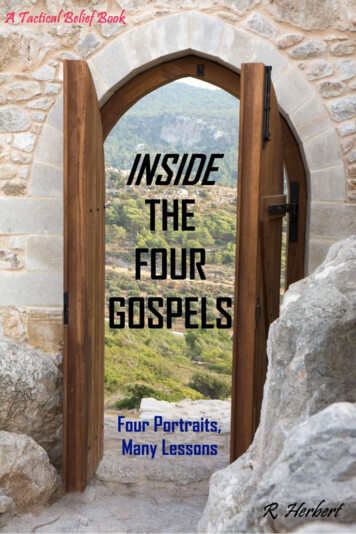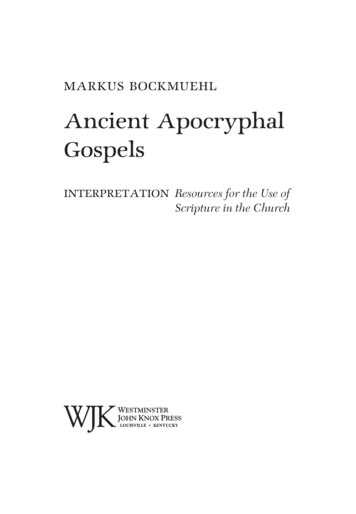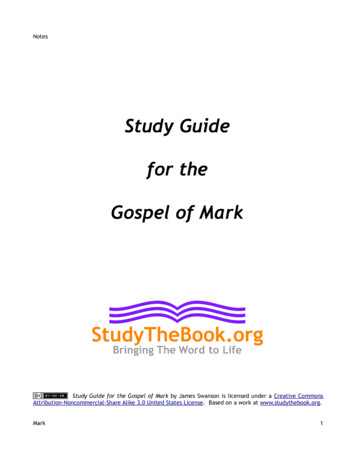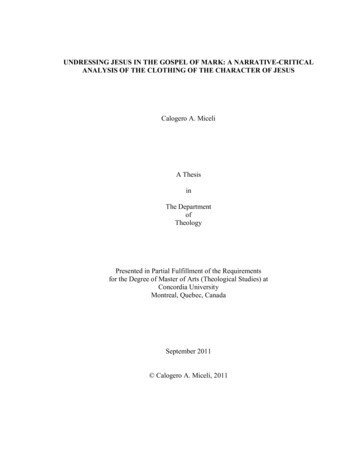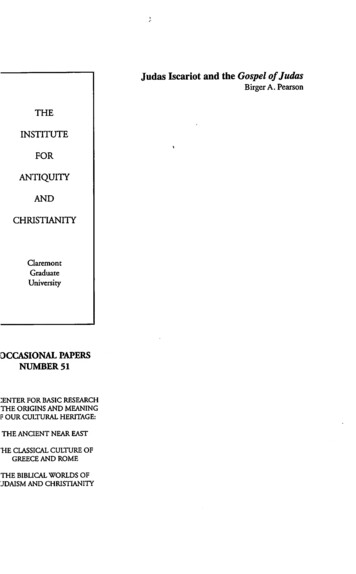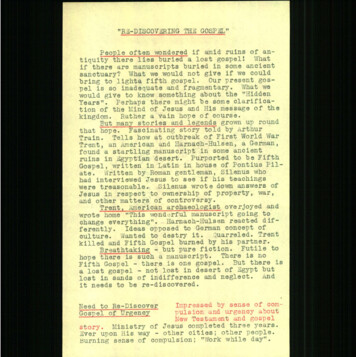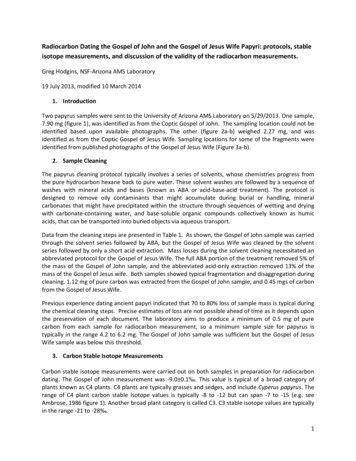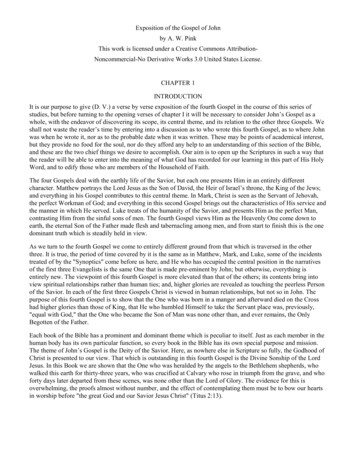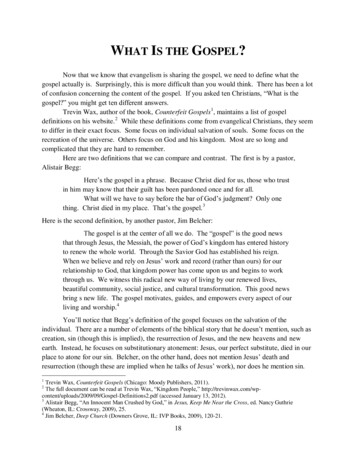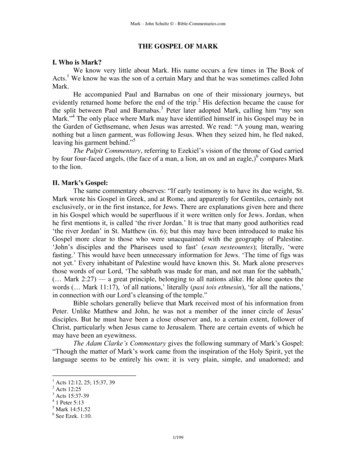
Transcription
Mark – John Schultz - Bible-Commentaries.comTHE GOSPEL OF MARKI. Who is Mark?We know very little about Mark. His name occurs a few times in The Book ofActs.1 We know he was the son of a certain Mary and that he was sometimes called JohnMark.He accompanied Paul and Barnabas on one of their missionary journeys, butevidently returned home before the end of the trip.2 His defection became the cause forthe split between Paul and Barnabas.3 Peter later adopted Mark, calling him “my sonMark.”4 The only place where Mark may have identified himself in his Gospel may be inthe Garden of Gethsemane, when Jesus was arrested. We read: “A young man, wearingnothing but a linen garment, was following Jesus. When they seized him, he fled naked,leaving his garment behind.”5The Pulpit Commentary, referring to Ezekiel’s vision of the throne of God carriedby four four-faced angels, (the face of a man, a lion, an ox and an eagle,)6 compares Markto the lion.II. Mark’s Gospel:The same commentary observes: “If early testimony is to have its due weight, St.Mark wrote his Gospel in Greek, and at Rome, and apparently for Gentiles, certainly notexclusively, or in the first instance, for Jews. There are explanations given here and therein his Gospel which would be superfluous if it were written only for Jews. Jordan, whenhe first mentions it, is called ‘the river Jordan.’ It is true that many good authorities read‘the river Jordan’ in St. Matthew (in. 6); but this may have been introduced to make hisGospel more clear to those who were unacquainted with the geography of Palestine.‘John’s disciples and the Pharisees used to fast’ (esan nesteountes); literally, ‘werefasting.’ This would have been unnecessary information for Jews. ‘The time of figs wasnot yet.’ Every inhabitant of Palestine would have known this. St. Mark alone preservesthose words of our Lord, ‘The sabbath was made for man, and not man for the sabbath,’( Mark 2:27) — a great principle, belonging to all nations alike. He alone quotes thewords ( Mark 11:17), ‘of all nations,’ literally (pasi tois ethnesin), ‘for all the nations,’in connection with our Lord’s cleansing of the temple.”Bible scholars generally believe that Mark received most of his information fromPeter. Unlike Matthew and John, he was not a member of the inner circle of Jesus’disciples. But he must have been a close observer and, to a certain extent, follower ofChrist, particularly when Jesus came to Jerusalem. There are certain events of which hemay have been an eyewitness.The Adam Clarke’s Commentary gives the following summary of Mark’s Gospel:“Though the matter of Mark’s work came from the inspiration of the Holy Spirit, yet thelanguage seems to be entirely his own: it is very plain, simple, and unadorned; and1Acts 12:12, 25; 15:37, 39Acts 12:253Acts 15:37-3941 Peter 5:135Mark 14:51,526See Ezek. 1:10.21/199
Mark – John Schultz - Bible-Commentaries.comsometimes appears to approach to a degree of rusticity or inelegance. Whoever reads theoriginal must be struck with the very frequent, and often pleonastic, occurrence ofeutheoos, immediately, and palin, again, and such like; but these detract nothing from theaccuracy and fidelity of the work. The Hebraisms which abound in it may be naturallyexpected from a native of Palestine, writing in Greek. The Latinisms which frequentlyoccur are accounted for on the ground of this Gospel being written for the Gentiles, andparticularly for the Roman people: this, it must be confessed, is only theory, but it is atheory which stands supported by many arguments, and highly presumptive facts.However this may be, the Gospel according to Mark is a very important portion of Divinerevelation, which God has preserved by a chain of providences, from the time of itspromulgation until now; and for which no truly pious reader will hesitate to render duepraise to that God whose work is ever perfect.”III. Time of writing:The Navigators’ study on Mark states: “Modern scholars almost unanimouslyagree that Mark’s was the earliest of the four Gospels. He probably wrote the book afterPeter died, but before Jerusalem fell, between A.D. 64 and 70. Mark like wrote in Rome,but some say his book could have been written in Egypt or Syria. It is clear, however, thatMark was written for Gentiles, or non-Jews. Mark revealed certain signs to point ustoward this conclusion; for example he explained Jewish practices, which presumes hisintended audience did not already know them. Also, Mark translated Aramaic words (theJewish language of the time) found in the text. If he were writing to Jewish people, heobviously wouldn’t have needed to do that.”IV. The keyword:The Greek word euthus, “immediately,” is the most typical word in Mark’sGospel. It is used more than forty times in this Gospel, giving Mark’s story “speed.”Mark gives us the impression that Jesus worked with great intensity, never losing amoment. Yet, we know that our Lord spent hours and sometimes whole nights infellowship with the Father.Bible scholars generally consider Mark’s emphasis on Jesus’ ministry as comingto earth as “the Servant.”We could consider Mark’s key verse to be: “For even the Son of Man did notcome to be served, but to serve, and to give his life as a ransom for many,”7 a statementwe find also in Matthew’s Gospel.8V. Outline:R. Alan Cole, in Mark9, gives the following outline:7Mark 10:43Matt. 20:289Tyndale New Testament Commentaries82/199
Mark – John Schultz - Bible-Commentaries.comI. PREPARE THE WAY: THE PREPARATION FOR THE EVANGEL (1:1-13) . 7A. THE TITLE OF THE BOOK (1:1) . 7B. THE FORERUNNER (1:2-8) . 7C. THE BAPTISM OF JESUS (1:9-11) . 10D. THE TEMPTATION (1:1-13) . 12II. HIS OWN DID NOT RECEIVE HIM: THE EARLY GALILEAN MINISTRY (1:143:6) . 12A. THE KINGDOM OF God IN GALILEE (1:14-45) . 12i. The first Galilean preaching (1:14-15) . 12ii. The call of the disciples (1:16-20) . 13iii. Jesus at Capernaum (1:21-28) . 14iv. Peter’s mother-in-law (1:29-31) . 16v. The evening healings (1:32-34) . 16vi. From Capernaum to Galilee (1:35-39). 17vii. The cleansing of the leper (1:40-45) . 18B. THE BEGINNING OF CONFLICT (2:1 – 3:6) . 19i. The healing of the paralyzed man (2:1-12) . 19ii. The ministry of Jesus (2:13) . 23iii. The call of Levi (2:14-17) . 23iv. Controversy about fasting (2:18-22) . 25v. Controversy about the Sabbath (2:23-28) . 27vi. The man with the withered hand (3:1-6) . 30III. ALL WHO RECEIVED HIM: THE CALL AND TRAINING OF THE DISCIPLES(3:7–8:26). 31A. THE CONFLICT INCREASES (3:7-35) . 31i. The breach with the religious leaders (3:7-12) . 31ii. The call of the twelve (3:13-19) . 33iii. Mounting opposition: the Beelzebul controversy (3:20-30). 35iv. The true relatives of Jesus (3:31-35). 38B. PARABLES OF THE KINGDOM (4:1-34) . 39i. The parable of the sower, and the reason for the use of parables (4:1-25) . 39ii. Two more parables of growth (4:26-32). 43iii. The summing up of the parables (4:33-34) . 46C. MINISTRY ROUND THE LAKE OF GALILEE (4:35 – 7:23) . 46i. Jesus calms the storm (4:35-41). 463/199
Mark – John Schultz - Bible-Commentaries.comii. The Gadarene demoniac (5:1-20) . 49iii. Two more healing miracles (5:21-43) . 53iv. His own city rejects Him (6:1-6) . 58v. The sending out of the twelve (6:7-13) . 59vi. Herod’s estimate of Jesus(6:14-16) . 61vii. The martyrdom of John the Baptist (6:17-29) . 61viii. The feeding of the five thousand (6:30-44) . 64ix. The walking on the water (6:45-52) . 66x. Healings at Gennesaret (6:53-56) . 69xi. A further clash with Judaism (7:1-23) . 70D. MINISTRY IN NORTHERN PALESTINE: RETURN TO GALILEE (7:24 – 8:26). 74i. The Syrophoenician woman (7:24-30) . 74ii. The deaf and dumb man (7:31-37) . 76iii. The feeding of the four thousand (8:1-9). 78iv. The Pharisees demand a sign (8:10-13) . 79v. The danger of yeast (8:14-21) . 80vi. The blind man of Bethsaida (8:22-26) . 82IV. HE FIRMLY SET HIS FACT: THE ROAD TO JERUSALEM (8:27 – 10:52). 84A. CONFESSION AND TRANSFIGURATION (8:27 – 9:10) . 84i. Peter’s confession: the first passion prediction (8:27-33) . 84ii. The cost of discipleship (8:34-38) . 86iii. The transfiguration (9:1-10) . 88B. THE PASSION FORETOLD AGAIN (9:11-50). 91i. ‘Elijah returned’ (9:11-13) . 91ii. The epileptic boy (9:14-29) . 92iii. The second passion prediction (9:30-32). 95iv. The greatest in the kingdom (9:33-37) . 96v. The man casting out demons (9:38-40) . 99vi. Stumbling-blocks (9:41-48) . 100vii. The salt of the earth (9:49-50) . 103C. DEPARTURE FROM GALILEE (10:1-34) . 104i. The local setting (10:1) . 104ii. The teaching of Jesus on marriage (10:2-12) . 104iii. Let the little children come (10:13-16) . 1064/199
Mark – John Schultz - Bible-Commentaries.comiv. The rich man (10:17-31) . 107v. The third passion-prediction (10:32-34) . 112D. THE SONS OF ZEBEDEE (10:35-45). 113E. BLIND BARTIMAEUS (10:46-52) . 117V. ZEAL FOR YOUR HOUSE: THE JERUSALEM MINISTRY (11:1 – 13:37) . 119A. ENTRY INTO JERUSALEM (11:1-14). 119i. The entry (11:1-10) . 119ii. The return to Bethany (11:11) . 121iii. Cursing the fig tree (11:12-14) . 122B. THE CLEANSING OF THE TEMPLE (11:15-19) . 123C. EXHORTATION AND DEBATE (11:20 – 12:44) . 126i. The meaning of the withered fig tree (11:20-26) . 126ii. By what authority? (11:27-33). 129iii. The wicked tenant-farmers (12:1-12) . 130iv. Tribute to Caesar (12:13-17). 132v. The Sadducean question (12:18-27) . 133vi. The greatest commandment (12:28-34) . 137vii. The son of David? (12:35-37). 139viii. The warning against the scribes (12:38-40) . 140ix. The widow’s gift (12:41-44) . 141D. THE LITTLE APOCALYPSE (13:1-37) . 141i. The doom of the temple (13:1-4) . 141ii. The signs of the end (13:5-8) . 142iii. The beginning of the troubles (13:9-13) . 143iv. The ‘desolating sacrilege’ (13:14-20) . 145v. False Christs and false prophets (13:21-23). 148vi. The coming of the Son of man (13:24-27) . 149vii. The parable of the fig tree (13:28-29). 150viii. The date of the coming (13:30-32) . 151ix. The end of the discourse (13:33-37) . 153VI. THE PASSION NARRATIVE (14:1 – 15:47) . 154A. THE LAST SUPPER (14:1-25) . 154i. The death of Jesus is decided (14:1-2). 154ii. The anointing at Bethany (14:3-9) . 1565/199
Mark – John Schultz - Bible-Commentaries.comiii. The betrayal by Judas (14:10-11) . 158iv. The owner of the upper room (14:12-16) . 159v. The prophecy of the betrayal (14:17-21) . 160vi. The Lord’s Supper (14:22-25) . 161B. THE AGONY IN GETHSEMANE (14:26-42) . 164i. The road to Gethsemane (14:26-31) . 164ii. The agony in the garden (14:32-42) . 166C. JESUS IS TAKEN PRISONER (14:43-52) . 169D. THE FALL OF PETER (14:53-72) . 171E. THE TRIAL BEFORE PILATE (15:1-15) . 177i. The stage is set (15:1) . 177ii. Pilate condemns Jesus (15:2-15) . 177F. THE CRUCIFIXION (15:16-47). 181i. The mockery (15:16-20) . 181ii. Carrying the cross of Jesus (15:21) . 182iii. The cross (15:22-32). 183iv. The death (15:33-41) . 186v. The burial (15:42-47) . 189VII. THE THIRD DAY: THE RISEN LORD (16:1-20) . 192A. THE RESURRECTION (16:1-8). 192B. THE LONGER ENDING (16:9-20) . 1946/199
Mark – John Schultz - Bible-Commentaries.comThe Text:I. PREPARE THE WAY: THE PREPARATION FOR THE EVANGEL (1:1-13)A. THE TITLE OF THE BOOK (1:1)1 The beginning of the gospel about Jesus Christ, the Son of GodR. Alan Cole, in Mark, states about the opening sentence: “The subject of thisgood news is a person named Jesus, a common enough name both in its Hebrew form ofJoshua, in Old Testament days, and in this Hellenized form, derived from the AramaicJeshua, in the New Testament world. Both by common etymology and by historicprecedent, the name meant ‘Yahweh is salvation,’ the name given to the divinelyappointed leader, sent to save God’s people in their hour of need. (Jos. 1:1-2). WhatMoses could not do, Joshua would accomplish: that would make the name ‘Jesus’ evenmore appropriate for the coming savior.Not alone, however, is Jesus to be Savior; He is also to be God’s appointed agentupon earth. This singling out for a particular task is described in terms of being‘anointed,’ as any king or priest of Old Testament days would have been. Both theconcept and the word are very common in the New Testament, occasionally in theSemitic form of Messiah, but more commonly as Christ, or ‘the Christ,’ using a wordderived from the Greek root chriō which has the same meaning as the Hebrew rootmāshah, ‘to anoint.’”There has been some question about whether the words “the Son of God” were inMark’s original manuscript or whether they are an addition by a later editor.The Navigators’ study on Mark states: “Gospel is an Old English word that means‘good news.’ It comes from the Greek word euvangelion. Eu means ‘good’ and angelionmeans ‘message.’”The Gospel could not have been described more concisely than Mark does here.The content of the message John the Baptist preached was that humanity ought to prepareitself for the coming of the Son of God, that is God coming to earth as a human being; theCreator becoming one of His own creations.The Wycliffe Bible Commentary states about Mark’s opening words: “Thesewords stand as a title indicating the content of the book as a whole. The gospel here is notthe book, but the message, the good news of salvation through Jesus Christ. The facts ofthe life and death of Christ make up the beginning of the gospel, which implies that theapostolic preaching was the continuation. To Mark, no less than to John, the deity ofChrist is of prime importance, and thus he includes it in the title of his Gospel.B. THE FORERUNNER (1:2-8)2 It is written in Isaiah the prophet: "I will send my messenger ahead of you, who willprepare your way"—3 "a voice of one calling in the desert, ‘Prepare the way for the Lord, make straightpaths for him.’"4 And so John came, baptizing in the desert region and preaching a baptism ofrepentance for the forgiveness of sins.7/199
Mark – John Schultz - Bible-Commentaries.com5 The whole Judean countryside and all the people of Jerusalem went out to him.Confessing their sins, they were baptized by him in the Jordan River.6 John wore clothing made of camel’s hair, with a leather belt around his waist, andhe ate locusts and wild honey.7 And this was his message: "After me will come one more powerful than I, the thongsof whose sandals I am not worthy to stoop down and untie.8 I baptize you with water, but he will baptize you with the Holy Spirit."According to Mark, the ministry of our Lord Jesus Christ began with theproclamation by His royal herald John the Baptist. The Pulpit Commentary observes: “Ithas been well observed that St. Matthew and St. John begin their Gospels from Christhimself; but St. Matthew from the human, and St. John from the Divine, generation ofChrist. St. Mark and St. Luke commence from John the Baptist; but St. Luke from hisnativity, and St. John from his preaching.”Passing by the birth and early years of Christ’s life, Mark turns at once to theopening events of the Lord’s public ministry. As predicted in the OT, Jesus was precededby a herald sent to prepare men for his appearance. John the Baptist came as the lastrepresentative of the old order with the express purpose of introducing the keypersonality of the new.”Barnes’ Notes writes about Mark’s beginning: “The word ‘gospel’ literallysignifies good news, and particularly the good tidings respecting the way of salvation bythe Lord Jesus Christ. Some have understood the word ‘gospel’ here to mean ‘history’ or‘life-the beginning of the history,’ etc.; but Mark says nothing of the early life of theSavior. The word ‘gospel’ here has reference rather to the preaching of John, an accountof which immediately follows, and means the beginning of the good news, orannunciation respecting the Messiah. It was very customary thus to prefix a title to abook.[The Son of God] This title was used here to attract attention, and secure therespect of those who should read the gospel. It is no common history. It does not recountthe deeds of man-of a hero or a philosopher-but the doctrines and doings of THE SONOF GOD. The history, therefore, ‘commands’ respect.”Referring to John’s ministry as Jesus’ herald, Mark quotes two Old Testamentprophecies, both of which he seems to ascribe both to Isaiah. The first one, however, isfrom Malachi, which reads literally: “‘See, I will send my messenger, who will preparethe way before me. Then suddenly the Lord you are seeking will come to his temple; themessenger of the covenant, whom you desire, will come,’ says the Lord Almighty.”10 Thesecond one is from Isaiah: “A voice of one calling: ‘In the desert prepare the way for theLord; make straight in the wilderness a highway for our God.’”11 John quoted Isaiah’swords himself when he was asked by a delegation of priests and Levites whether he wasthe Messiah.12 Actually, all four Gospel writers refer to John’s words, although they donot all give them as a literal quotation.What Mark seems to be saying is that the preaching of the Good News began withJohn the Baptist. By saying this, Mark actually penetrates to the core of the message. It is10Mal. 3:1Isa. 40:312John 1:19-23118/199
Mark – John Schultz - Bible-Commentaries.comtrue that all John the Baptist did was to prepare the way for the coming of Jesus. In Paul’swords: “John’s baptism was a baptism of repentance. He told the people to believe in theone coming after him, that is, in Jesus.”13 But John did also point out that Jesus was “theLamb of God, who takes away the sin of the world!”14 So we can say truly that thepreaching of the Gospel began with John.Mark describes briefly that John preached his message “in the desert region,”which must have been at the eastern bank of the Jordan River. From a strategic angle,choosing a desert area as a place to preach seems the wrong approach. A preacher issupposed to go to where the people are, not to expect that people come to him. Johnproved a point, made centuries later by Ralph Waldo Emerson: “If a man preaches abetter sermon, or builds a better mousetrap, the world will beat a path to his door.”John the Baptist’s ministry consisted not only of preaching, but also baptizing.This rite must have been an accepted way of demonstrating a person’s determination tofollow up on a decision made. John did not invent the rite; he practiced an accepted ritualthat was understood by all. We could compare it to people’s reaction to a call, such asnowadays would be the raising of a hand in a Gospel meeting. Baptism was obviouslysome more involved than raising one’s hand.Fausset’s Bible Dictionary states about John’s baptizing: “John’s ‘baptism ofrepentance for the remission of sins’ (Luke 3:3) was the pledge his followers took of theirdetermination to separate themselves from the prevalent pollutions, as the needfulpreparation for receiving the coming Messiah, who remits the sins of His believingpeople. The ‘remission’ was not present but prospective, looked for through Messiah, notthrough John (Acts 10:43). John’s baptism was accompanied with confession (Matt 3:6),and was an act of obedience to the call to renounce all sin and believe in the comingRedeemer from sin. The universal expectation of the Messianic king ‘in the whole East’ made all ready to flock to the forerunner. The Jews hoped to be delivered fromRome’s supremacy (Mal 3:1; 4:5-6). The last of the prophets had foretold the coming ofElijah before the great day of the coming of the Lord, the Sun of righteousness, themessenger of the covenant. Elijah was to ‘turn the heart of the fathers to the children, andthe heart of the children to their fathers,’ namely, the disobedient children to the faith andfellowship of their pious forefathers, Abraham, Jacob, Levi, Elijah (Luke 1:17), lestMessiah at His coming ‘should smite the earth with a curse.’”Mark’s description of John the Baptist’s lifestyle emphasizes his choice ofsimplicity. This was demonstrated in his clothing and his daily diet. The Greek word usedhere for “locust” is akris, which may refer to the insect we know or to the top of a certainplant. There is, however, no reason to believe that John the Baptist was a vegetarian.According to the list in Leviticus of kosher insects one was allowed to eat, this kind wasamong the edible ones. We read: “Of these you may eat any kind of locust, katydid,cricket or grasshopper.”15 Clothes made of camel hair, which probably means camel skin,were probably the cheapest kind of clothing one could wear. John may also have wornthat kind of clothing in order to dress like the Old Testament prophet Elijah whom he was13Acts 19:4John 1:2915Lev. 11:22149/199
Mark – John Schultz - Bible-Commentaries.comsupposed to resemble. Describing Elijah to king Ahaziah, one of that king’s servants said:“He was a man with a garment of hair and with a leather belt around his waist.”16Mark does not go into any further detail about John the Baptist’s preaching, apartfrom the fact that John announced the coming of the Messiah, to whom he comparedhimself as being so much lower that he would not even qualify as the Messiah’s lowestslave. John did not belittle the repentance of those who came to him for baptism. He musthave believed in the forgiveness he preached as a fruit of repentance. But he could notguarantee regeneration, which was needed for the new life that God desired. Heunderstood that baptism with the Holy Spirit was needed for spiritual regeneration.The Pulpit Commentary comments on John’s words: “It is as though he said,‘Christ will pour his Holy Spirit so abundantly upon you, that he will cleanse you fromall your sins, and fill you with holiness and love and all his other excellent graces.’ Christdid this visibly on the day of Pentecost. And this he does invisibly in the sacrament ofHoly Baptism, and in the rite of Confirmation, which is the completion of the sacramentof Baptism. John baptized with water only, but Christ with water and the Holy Spirit.John baptized the body only, Christ baptizes the soul. By how much, therefore, the HolySpirit transcend
The Adam Clarke’s Commentary gives the following summary of Mark’s Gospel: “Though the matter of Mark’s work came from the inspiration of the Holy Spirit, yet the language seems to be entirely his own: it is very plain, simple, and unadorned; and 1 Acts 12:12, 25; 15:37, 39 2
